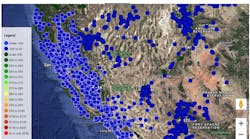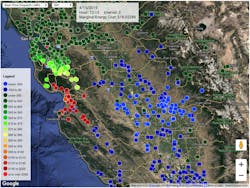In this series, we discuss how smart meter interval data, combined with open source methods and software, can provide transparent measurement of load shape changes (resource curves) and integration of demand flexibility into energy markets. For demand flexibility to scale, utilities must be able to procure it in the same way they procure other resources — by sending time-and-location specific price signals. Pay-for-performance (P4P) program models for demand flexibility programs can provide for accountability and align incentives throughout the market toward solving real grid needs. P4P based on transparent measurement presents a new opportunity for market-based programs that can scale by attracting private investment and securing financing.
How performance-based, behind-the-meter interventions can help address load-shape challenges, integrate renewables, and facilitate non-wires alternatives (NWAs)
To effectively integrate renewable resources into the grid, utilities need to address the growing load shape challenges driven by variability and electrification of heating and transportation. At the same time, they will need to confront ongoing challenges; costly transmission and distribution (T&D) upgrades, the retirement of legacy power plants, and the need to design for resilience in the wake of climate change and other natural disasters.
In this context, behind-the-meter solutions, such as energy efficiency, demand response, and storage should not be considered goals in and of themselves but viewed instead as integrated flexibility resources that can serve as a virtual NWA power plant that load-serving entities use to defer upgrades, avoid building dirty and expensive new generation, and enable higher saturation of carbon-free renewables.
To meet these objectives, flexibility resources must move beyond traditional designs and evaluation approaches to deliver reliable, verifiable changes in demand that meet specific time-and-locational grid needs. The first steps in this evolution are already underway. Meter-based P4P approaches that pay time-varying incentives for aggregated load impacts are currently being administered by leading utilities and other entities around the country, including in California, New York, and Oregon. These P4P programs determine hourly load impacts via open-source CalTRACK methods that are carried out through the OpenEEmeter.
Demand Flexibility Will be Essential for Affordable Decarbonization
Grids with high saturation of solar or wind generation are already struggling to address the mismatch between intermittent supply and demand. In these cases, variability is contributing to regular periods of over- and undersupply, and periods of negative energy prices — where there are more clean electrons than demand to use them.
Take April of 2019 as an example, where the California Independent System Operator (CAISO) reported that 11% of all five-minute intervals on California’s grid experienced negative pricing and 194 GWh of wind and solar resources were curtailed. As of Nov. 12, the CAISO reported that 2019 renewables curtailment has reached 838 GWh, exceeding all of 2018 by 82%. This level of curtailment amounts to more than half of the first-year electricity savings achieved by California’s entire resource EE portfolio, at a cost of around US$500 million. The problem is getting worse. By 2025 the California Public Utilities Commission (CPUC) forecasts overgeneration in more than 50% of hours between 7 a.m. and 5 p.m. By 2030 that value reaches 67%.
These facts make clear that that saving energy at the wrong times or places can actually make grid problems worse, cost ratepayers money (such as when California pays neighboring states to take clean power or utilities pay generators to curtail), and have little to no carbon impacts. With many states aggressively pursuing renewables and clean energy goals, these issues will not be isolated to the west coast.
Managers hoping for energy storage technology to advance rapidly, prices to fall exponentially, and deployment to scale swiftly may not be fully informed. Currently, storage is expensive and in short supply. More importantly, even if coupled renewable and storage solutions can scale quickly and overcome seasonal imbalances, the problem of peak demand still exists. Replacing dirty peaker fossil fuel plants with clean peaker storage facilities is an enormously costly proposition.
As more states and utilities commit to aggressive decarbonization goals, the electric grid must transition from a centralized, fossil-fuel based system to one that is anchored by clean and often distributed sources of energy such as solar and wind.
In this context, reliable reductions of peak load brought about via well-designed, diverse, and metered efficiency interventions, demand response, storage, and load shifting will be important for affordable decarbonization, including via electrification. Taken together, this focused, comprehensive approach to behind-the-meter resources is demand flexibility.
The Need for Consistent Measurement and Valuation
In order to facilitate competitive demand flexibility markets, a structure for apples-to-apples valuation with other resources is essential. Just as you can’t buy a pound of rice or a gallon of gas without all parties having confidence in the measurement system, a utility can’t procure a kilowatt hour of demand flexibility without knowing ahead of time how it will be determined, paid, and verified. The need for standard measurement is so important that it is called out directly in the U.S. Constitution, which gives Congress the power to "fix the Standard of Weights and Measures." Yet after many decades of programs and evaluation, we’ve never had this foundational element established in our industry.
Instead, to even know what a kilowatt hour of savings means, we have to first specify ex ante or ex post, net or gross, existing conditions, code, or industry-standard practice baseline, single or dual baseline...the list goes on. Then we have to measure it, which itself is the source of multi-year delays, contention, judgment calls, and controversy.
Without being able to agree within our own industry or provide markets standard tools to manage or value risk and support investment, it should be no surprise that utility EE investment hovers around 1% of electricity and gas expenditures — not exactly taking advantage of the scale implied by our perch as a “first in the loading order” resource.
Fortunately, there is now a better way. With behind-the-meter P4P programs rooted in standardized, transparent, and timely metered measurement, it is finally possible to cultivate a real demand flexibility market that can innovate with confidence.
Weights and Measures for Demand Flexibility
The challenge of measuring demand flexibility lies in establishing the “counterfactual” or “what would have happened in the absence of the program.” For demand flexibility to compete as a legitimate resource we must address two measurement questions. First, how should the counterfactual be computed? Second, why should everyone have confidence in the results?
The solution comes from meter-based measurement with fully open source methods and deployable code that allows verification and replication by all parties. The CalTRACK methods and their implementation via the OpenEEmeter open-source codebase enables demand flexibility calculations via fully-specified, rigorous, tested, and standardized methods. The CalTRACK methods were developed starting in 2012 through an open stakeholder process led by Pacific Gas and Electric (PG&E) and eventually including the California Energy Commission (CEC), the CPUC, several California investor-owned utilities, the New York State Energy Research and Development Authority (NYSERDA), and Energy Trust of Oregon, as well as implementers, evaluators, and academic researchers. The OpenEEmeter, initially developed as an open source tool by OpenEE (now Recurve), contains reference implementations of standard CalTRACK methods. Both CalTRACK and the OpenEEmeter are now hosted by Linux Foundation Energy. Everyone can participate in the CalTRACK Methods process and has the same access to the OpenEEmeter code for free, and without restriction.
The CalTRACK methods cover every important detail, including data cleaning and sufficiency, weather station selection, and full model specifications among many other considerations that are often handled by “professional judgement.” The hourly methods are both rigorous and advanced, with weather normalization, normalization to building state or “occupancy,” variable balance point temperatures and non-linear temperature dependence allowed via the specification of distinct models for up to seven different temperature bins.
Using these open CalTRACK methods, we can now calculate the hourly impact on demand of portfolios of behind-the-meter interventions with full transparency in near real-time. These measurements allow utilities to procure flexibility based on the grid and carbon value of interventions. We call this impact on load shape the Resource Curve.
The PG&E in California is one of the earliest adopters of this procurement model. The PG&E’s residential efficiency P4P program uses the CalTRACK methods and the OpenEEmeter to calculate and pay efficiency aggregators for achieved savings, with a three-fold multiplier applied during the system peak period between 4 p.m. and 9 p.m.
The PG&E’s approach is becoming the norm in California. Earlier this year, the CPUC released guidance for the application of Normalized Metered Energy Consumption (NMEC) to aggregate (population-level) analysis for budding energy efficiency programs. Using NMEC is the first step toward market-based procurement of demand flexibility.
Energy Trust of Oregon and the NYSERDA are also piloting P4P programs using CalTRACK and the OpenEEmeter, with other localities following soon.
In our next article, we discuss resource curves in more detail, including how they can transform the way efficiency and other demand-side resources can be integrated, procured, and deployed with confidence.




